Mostar is one of the largest cities of Bosnia & Herzegovina and is the most important city within the Herzegovina region itself. Just to give you a little background, the reason I posted Sarajevo as part of "Bosnia" and not "Bosnia & Herzegovina" is because it lies in the country of Bosnia but outside the Herzegovina region. Mostar is within that region. Originally, it was all just the Kingdom of Bosnia. In 1448, with the decline in the power of the Kingdom of Bosnia with the death of Tvtko I, and with pressure from the Serbian Kindgom to the east, Duke Stjepan Vukčić Kosača of the southern lands of Bosnia sent a letter to the Holy Roman Emperor Frederick III declaring himself "herzog" (duke in German) and controller of his lands. His lands henceforth became known as Herzegovina (Herzog's lands).
It is thus that "Bosnia & Herzegovina" is a bit confusing. It would be similar to Texas seceding from the Union, then rejoining but the country being called The United States of America & Texas. But, to be less confusing and save on title space, I'm designating the "country" of each of the two cities I visited as their current respective "regions" if you will. Confused yet? You will be. I wanted to visit Mostar specifically because of one thing: Stari Most. It was an Ottoman bridge dating back 427 years, from November 9, 1993. Why that date? That was the day the bridge was intentionally destroyed by artillery fire from the Croat forces during the Bosnian War. The Croat forces claimed it was of strategic importance but the most common belief is that it was destroyed to send a message: the old ways are dead.
A bit chilling, and very sad. Thankfully the bridge has been rebuilt and it's just as beautiful as before- maybe too much so. The locals say it looks "too new" now, ha. The other reason I wanted to visit Mostar was because I kept hearing about this incredible tour run by a guy named Bata from Hostel Majdas. Originally I was only planning to stop into Mostar for a few hours and see the bridge, but I emailed Bata to see if he would be running the tour that day and sure enough he was. So I decided to book a night at the hostel and join up with the tour.
Fortuitously, we left off last time at that exact point- Bata picking me up (from my late train) and the tour commencing. The first thing I will say about Bata is that he's high strung- an absolute ball of energy. I don't know where he gets it from, he doesn't even drink coffee! Bata's family is Muslim descent although further back they are Catholic, however, I believe the family doesn't actively practice religion. Unfortunately, during the war, all that was required to be a target was a last name that sounded Muslim. He and his family were fortunate enough to be smuggled out of the country and he lived in Sweden for numerous years before finally returning home.
His experiences with people in Sweden and interaction with backpackers led him to become curious about the lifestyle. To make a long story short, when he arrived back in Mostar he started the city's first listed hostel on hostelworld and hostelbookers. He would drive backpackers to and from the airport, train station, and bus station and was always asked questions about the history of the city and its sights. He started learning more and more and eventually he offered to show a group around some of the lesser-known sites in Mostar and the surrounding area. The legendary tour pretty much evolved from there.
The thing that makes Bata's tour so great is that he works really hard to make it exceptionally fun and he offers a no-bullshit type narrative. He is telling the story, the truth from his perspective, as he sees it. This creates for some blunt, poignant, and occasionally heartbreaking stories. But it is absolutely fascinating to hear the story of Mostar and Bosnia from his point of view- and not just about the war, but about the history, philosophy, and culture of the peoples of Bosnia. I wish I could transcribe here all of the points he made that would cause us to rethink our assumptions or look at events in a different light, but then that would eliminate the incentive to go on the tour wouldn't it? And the last thing I want to do is cannibalize his business! I will weave in a few bits and pieces as I describe the happenings of that fateful day in Mostar.
The first thing he tells us is, "This is not a tour of the old town or the bridge. We are not going there. If you want to see it, walk there on your own time. I will show you the real Mostar." And with that, we were off, but not before he fired up the strobe lights, disco ball, and blasted Bosnian turbopop (like techno or dance music) in his 10 seater van and mashed the gas pedal to the floor. Bata drives that van as if his ultimate goal is to cause the wheels to rip away from the axels. To say he drives erratically would be an gross exaggeration of the word erratically. He drives, intentionally, so that those of us on the tour are bouncing around like Jim Carrey in that scene from Ace Ventura 2. I have a video that I will eventually post.
Our first stop on the tour is a town called Medugorje, a place where over 1 million Catholics visit every year on pilgrimage. The reason for the pilgrimages is because on the 24 of June, 1981 six children claimed they saw an apparition of the Virgin Mary up in the hills near the town. It is now one of the most visited pilgrimage sites in the world and the third most popular "apparition site" in Europe. There is a really nice Cathedral in the town, which at the time of the apparition had no more than 25 houses, and curiously enough it was built just prior to the sighting... hmmm.
Today there is a white statue of the Virgin Mary at the spot on the hill where the children saw the apparition. You can walk there from near the town but since it is several hours up and back, it's not part of Bata's tour. The most interesting thing about Medugorje to me, however, is not the Cathedral or the apparition, but the absolute explosion of commerce and exploitation of the "miracle."
The town went from a sleepy village to a bustling tourist center with dozens of Virgin Mary gift shops, hotels, and lodges for Catholics of just about every geographic region to hang with their regional counterparts. Even big name musicians travel there to perform at the Cathedral's outdoor performance venue. Yes, you read that correctly. And one of the six children still lives in the village and she claims she sees or hears the Virgin Mary on almost a daily basis. People come by from all over to see her and say hello, and of course, buy something from the gift shop she has set up on the ground floor of her house.
Is all this commercialization shameful? Yes. But is it a brilliant scheme for creating an influx of wealth into a poor local community? Absolutely! It's capitalism at its best. Convince people you have a product that they need and then watch as the money piles up. It's also worth noting that all of these pilgrims show up every year even though the Pope and Vatican have openly opposed it as an official apparition. Perhaps even more powerful than any deity: the power of good marketing!
Our next destination was to be some Bosnian waterfalls. I didn't really know what to expect with Bosnian waterfalls but as prescribed by the guy who first picked me up at the train station, I had my swimsuit and towel and I was ready to rock. On our way we passed something that should ring a bell if you bothered to read the first 3 paragraphs of this post: Herzog's Castle. This was one of the seats of power for 15th century Herzegovina.
It's the building on the hill- not the new house in the foreground. Just in case you, like me, were temporarily confused. Next stop: waterfalls baby. I have to confess, I kind of have a thing for falling water. Well, I have a thing for water period, but especially cool/cold falling water. I don't think I've ever told anyone this so you lucky few get a little tid bit about the psyche of Mike Steele: whenever I'm having a really drag-ass morning or I'm feeling a bit down in the dumps, I like to turn on the shower head to full cold and let it splash into the tub/shower. I then sit next to it and listen and feel the resulting cool misty air drift over me. I find it incredibly relaxing and soothing. As you might imagine, the opportunity to hang out at a series of real waterfalls, let alone go climbing and swimming in them, had me extremely fired up.
We spent the next two hours climbing all over those rocks, into hidden caves and grottoes, and swimming in the waterfall pools. At the end you could dive off the rocky cliff to the right into the main pool. Can't really describe how awesome it was. I wish I had a waterproof camera so I could have gotten some shots inside the waterfall area. I made the most of my time and scaled nearly every square inch and swam under every single waterfall. Brisk baby! They also have a cool old wooden bridge to the side closest to the waterfalls so the "tourists," as Bata puts it, can get close to them. We dove right in from right side of the pool and swam over.
And all that brown/grey stuff hanging down is moss on the outside of the rocks. That picture was taken from the balcony of the restaurant where we had lunch. For about 4 or 5 euro we had this massive spread of grilled meats, salad, bread, fried potatoes, tomatoes, and cucumbers. And everyone sampled a rakija, which is a spirit made of the leftover grape skins, seeds, and other byproduct from making wine. If you've tried grappa, it's basically the exact same thing. Very very harsh. I don't recommend it, but who am I to say? I love absinthe. These girls agreed with me though.
Our next stop on the tour was a medieval town called Počitelj. It was founded in the late 1300's and had varying levels of importance during the Ottoman and Austro-Hungarian rule. In the latter period, its strategic importance as a military center waned and thus the village was preserved more or less in its present form. In 1993, however, the village was bombed by Croat forces destroying most of the ancient Islamic buildings and works of art. Worse, most of the village's citizens were rounded up and placed into concentration camps. Many did not make it out alive and a large portion of those that did fled the area and have not returned to the city. As such, there are almost no full-time inhabitants of the town and it continues to deteriorate. But what remains is spectacular.
We arrived at the perfect time and we got to see it at sunset and just at dusk, providing two contrasting but equally amazing views. As we gazed out over the town, Bata informed us of the history of the religion of the initial founders of the town, the Bogomils. They practiced a form of Christianity that included a bit of a blend of many religions and called for a return to early simplistic worship. They didn't believe in using crosses or building churches. They worshiped outdoors or at neighbors houses, and they believed the closer they were to more spectacular features of nature, the closer they were to god.
Because the vast majority of Bosnians are in some way descended from these Bogomils, Bata strongly identified with them and cited that as a major force in the "Bosnian spirit." That is, the indefatigable attitude of the Bosnian people- refusing to be provoked, refusing to back down, standing their ground to protect what they believe in, and simply rebuilding and moving forward when they are bested. I really liked the way he put it. Far to often we are so focused on who we are or who we want to be, we lose sight of how we came to be who we are in the first place. We forget about where we came from and what was required to forge the life and spirit that defines our character. And gazing out over this mystic place, it's easy to see how he draws such inspiration.
As the sun set over Počitelj, we all assumed our time at this little town was finished. We were wrong. Bata had a special surprise for us: refreshments in the garden of one of the few local women still living in the village. And when I say refreshments, I really mean a feast! First we were treated to proper Bosnian coffee. Then we had three special homemade syrups that were mixed with water to make a sweet juice-like drink, mint, elderflower, and pomegranate. The elderflower was served with seltzer water which Bata jokingly called "Bosnian champagne."
In addition to the drinks we were served walnut and fig cake, various biscuits, dried figs, dates, and apricots, and a huge platter of fresh fruits including cantaloupe, grapes, peaches, plums, cherries, and figs- all grown in her garden. It was my first time trying fresh figs and... oh... my... goodness. My only previous experience had been with Fig Newtons (which I inhale by the sleeve mind you). But these little golden gems might just be my new second favorite fruit behind comice pears! So freaking good. And in the Balkans, fig trees abound. You can just stroll down a street, rip one off, and gobble it down. Figs are nearly worth their weight in gold in NYC!
After sedating us with all these drinks and delicious snacks, Bata had another surprise for us. He had us wait by the roadside while he got the van and then, with disco lights swinging and turbopop blasting, he cruised past us in the van with the doors open shouting "run for your lives!!" So we took off after it at a sprint and all leaped aboard the moving vehicle. Good times. We bounced and bumped flying down the streets to our last stop on the tour: Blagaj Tekija.
Remember when I mentioned the Bogomils loved to be near spectacular natural sites? Well they were among the first to establish these cliffs and the underground water source for the Buna river as a place of worship. In the 16th century, the Muslim Dervishes began constructing the buildings that currently exist. The site was eventually used by the Dervishes as a quasi-outreach center- providing meals and lodging for other impoverished people as well as acting as a hub for scientific and intellectual gatherings and discussion.
Interestingly, the Dervishes became frustrated when so many people started showing up for free meals and lodging. Their solution was to build a mill so the people from the surrounding villages could mill their own grain into flour. Then, as the farmers began to have surplus they asked the Dervishes permission to use the mill to make flour to sell as a business. The Dervishes agreed on the condition that 50% of the money went back to the Dervishes for redistribution in other public works programs.
The debate over capitalism versus socialism continues to rage on. Personally, I don't think either system works unchecked. But here, in this tiny little place near Mostar, the Dervishes created a simple self-sustaining hybrid system that allows for both the ability to have a business and improve your quality of life but also for money to be collected and used for the better good of the less fortunate. Is it that hard to envision an application of this in a major world economy?
In my mind the only thing preventing this from working is fundamental flaws in human nature: power and greed. But if a system like this were to exist, could such flaws be curbed if not controlled entirely? I think we see a little of this these days with high tax regimes and socialized health care and retirement, but imagine a system that didn't use those levies to support, but instead consistently reallocated them toward new self-sustaining works like the grain mill? Where the more money is made, the more opportunities open up for every citizen? Maybe I've gone a bit soft in my travels but the thought of a perpetuating system of societal well being gives me chill bumps. It's the evolution (or maybe perversion) of the economist in me.
Enough socioeconomic rambling for one post. You're probably wondering... what happened next!? Well not much actually. By this point it was around 10pm and it was the tour terminus so we headed back to the hostel. Prior to bed, however, we caught a lift to a nearby bakery where I tried my first burek. It's basically a roti-style pastry wrapped around minced meat (or cheese or vegi). SO GOOD! In the morning, I was woken up by this woman who gathered us all around the breakfast table for her creation: little fried doughs. That's the best way I can describe them. You could eat them with jams or nutella or cheese or plain if you so chose. They were really good and she was really slinging these things. Like a one-woman Krispy Kreme doughnut shop.
She was so cute. After my breakfast I had about 2 hours to roam old town and see Stari Most before it was time to make my way to the bus station and onward to Dubrovnik. Since I've already talked a ton about Stari Most, I'll save you more reading and just show you some pictures. Here's one from the bridge near to the hostel:
And here is one from next to it:
Fortuitously, we left off last time at that exact point- Bata picking me up (from my late train) and the tour commencing. The first thing I will say about Bata is that he's high strung- an absolute ball of energy. I don't know where he gets it from, he doesn't even drink coffee! Bata's family is Muslim descent although further back they are Catholic, however, I believe the family doesn't actively practice religion. Unfortunately, during the war, all that was required to be a target was a last name that sounded Muslim. He and his family were fortunate enough to be smuggled out of the country and he lived in Sweden for numerous years before finally returning home.
His experiences with people in Sweden and interaction with backpackers led him to become curious about the lifestyle. To make a long story short, when he arrived back in Mostar he started the city's first listed hostel on hostelworld and hostelbookers. He would drive backpackers to and from the airport, train station, and bus station and was always asked questions about the history of the city and its sights. He started learning more and more and eventually he offered to show a group around some of the lesser-known sites in Mostar and the surrounding area. The legendary tour pretty much evolved from there.
The thing that makes Bata's tour so great is that he works really hard to make it exceptionally fun and he offers a no-bullshit type narrative. He is telling the story, the truth from his perspective, as he sees it. This creates for some blunt, poignant, and occasionally heartbreaking stories. But it is absolutely fascinating to hear the story of Mostar and Bosnia from his point of view- and not just about the war, but about the history, philosophy, and culture of the peoples of Bosnia. I wish I could transcribe here all of the points he made that would cause us to rethink our assumptions or look at events in a different light, but then that would eliminate the incentive to go on the tour wouldn't it? And the last thing I want to do is cannibalize his business! I will weave in a few bits and pieces as I describe the happenings of that fateful day in Mostar.
The first thing he tells us is, "This is not a tour of the old town or the bridge. We are not going there. If you want to see it, walk there on your own time. I will show you the real Mostar." And with that, we were off, but not before he fired up the strobe lights, disco ball, and blasted Bosnian turbopop (like techno or dance music) in his 10 seater van and mashed the gas pedal to the floor. Bata drives that van as if his ultimate goal is to cause the wheels to rip away from the axels. To say he drives erratically would be an gross exaggeration of the word erratically. He drives, intentionally, so that those of us on the tour are bouncing around like Jim Carrey in that scene from Ace Ventura 2. I have a video that I will eventually post.
Our first stop on the tour is a town called Medugorje, a place where over 1 million Catholics visit every year on pilgrimage. The reason for the pilgrimages is because on the 24 of June, 1981 six children claimed they saw an apparition of the Virgin Mary up in the hills near the town. It is now one of the most visited pilgrimage sites in the world and the third most popular "apparition site" in Europe. There is a really nice Cathedral in the town, which at the time of the apparition had no more than 25 houses, and curiously enough it was built just prior to the sighting... hmmm.
Today there is a white statue of the Virgin Mary at the spot on the hill where the children saw the apparition. You can walk there from near the town but since it is several hours up and back, it's not part of Bata's tour. The most interesting thing about Medugorje to me, however, is not the Cathedral or the apparition, but the absolute explosion of commerce and exploitation of the "miracle."
The town went from a sleepy village to a bustling tourist center with dozens of Virgin Mary gift shops, hotels, and lodges for Catholics of just about every geographic region to hang with their regional counterparts. Even big name musicians travel there to perform at the Cathedral's outdoor performance venue. Yes, you read that correctly. And one of the six children still lives in the village and she claims she sees or hears the Virgin Mary on almost a daily basis. People come by from all over to see her and say hello, and of course, buy something from the gift shop she has set up on the ground floor of her house.
Is all this commercialization shameful? Yes. But is it a brilliant scheme for creating an influx of wealth into a poor local community? Absolutely! It's capitalism at its best. Convince people you have a product that they need and then watch as the money piles up. It's also worth noting that all of these pilgrims show up every year even though the Pope and Vatican have openly opposed it as an official apparition. Perhaps even more powerful than any deity: the power of good marketing!
Our next destination was to be some Bosnian waterfalls. I didn't really know what to expect with Bosnian waterfalls but as prescribed by the guy who first picked me up at the train station, I had my swimsuit and towel and I was ready to rock. On our way we passed something that should ring a bell if you bothered to read the first 3 paragraphs of this post: Herzog's Castle. This was one of the seats of power for 15th century Herzegovina.
It's the building on the hill- not the new house in the foreground. Just in case you, like me, were temporarily confused. Next stop: waterfalls baby. I have to confess, I kind of have a thing for falling water. Well, I have a thing for water period, but especially cool/cold falling water. I don't think I've ever told anyone this so you lucky few get a little tid bit about the psyche of Mike Steele: whenever I'm having a really drag-ass morning or I'm feeling a bit down in the dumps, I like to turn on the shower head to full cold and let it splash into the tub/shower. I then sit next to it and listen and feel the resulting cool misty air drift over me. I find it incredibly relaxing and soothing. As you might imagine, the opportunity to hang out at a series of real waterfalls, let alone go climbing and swimming in them, had me extremely fired up.
We spent the next two hours climbing all over those rocks, into hidden caves and grottoes, and swimming in the waterfall pools. At the end you could dive off the rocky cliff to the right into the main pool. Can't really describe how awesome it was. I wish I had a waterproof camera so I could have gotten some shots inside the waterfall area. I made the most of my time and scaled nearly every square inch and swam under every single waterfall. Brisk baby! They also have a cool old wooden bridge to the side closest to the waterfalls so the "tourists," as Bata puts it, can get close to them. We dove right in from right side of the pool and swam over.
And all that brown/grey stuff hanging down is moss on the outside of the rocks. That picture was taken from the balcony of the restaurant where we had lunch. For about 4 or 5 euro we had this massive spread of grilled meats, salad, bread, fried potatoes, tomatoes, and cucumbers. And everyone sampled a rakija, which is a spirit made of the leftover grape skins, seeds, and other byproduct from making wine. If you've tried grappa, it's basically the exact same thing. Very very harsh. I don't recommend it, but who am I to say? I love absinthe. These girls agreed with me though.
Our next stop on the tour was a medieval town called Počitelj. It was founded in the late 1300's and had varying levels of importance during the Ottoman and Austro-Hungarian rule. In the latter period, its strategic importance as a military center waned and thus the village was preserved more or less in its present form. In 1993, however, the village was bombed by Croat forces destroying most of the ancient Islamic buildings and works of art. Worse, most of the village's citizens were rounded up and placed into concentration camps. Many did not make it out alive and a large portion of those that did fled the area and have not returned to the city. As such, there are almost no full-time inhabitants of the town and it continues to deteriorate. But what remains is spectacular.
We arrived at the perfect time and we got to see it at sunset and just at dusk, providing two contrasting but equally amazing views. As we gazed out over the town, Bata informed us of the history of the religion of the initial founders of the town, the Bogomils. They practiced a form of Christianity that included a bit of a blend of many religions and called for a return to early simplistic worship. They didn't believe in using crosses or building churches. They worshiped outdoors or at neighbors houses, and they believed the closer they were to more spectacular features of nature, the closer they were to god.
Because the vast majority of Bosnians are in some way descended from these Bogomils, Bata strongly identified with them and cited that as a major force in the "Bosnian spirit." That is, the indefatigable attitude of the Bosnian people- refusing to be provoked, refusing to back down, standing their ground to protect what they believe in, and simply rebuilding and moving forward when they are bested. I really liked the way he put it. Far to often we are so focused on who we are or who we want to be, we lose sight of how we came to be who we are in the first place. We forget about where we came from and what was required to forge the life and spirit that defines our character. And gazing out over this mystic place, it's easy to see how he draws such inspiration.
As the sun set over Počitelj, we all assumed our time at this little town was finished. We were wrong. Bata had a special surprise for us: refreshments in the garden of one of the few local women still living in the village. And when I say refreshments, I really mean a feast! First we were treated to proper Bosnian coffee. Then we had three special homemade syrups that were mixed with water to make a sweet juice-like drink, mint, elderflower, and pomegranate. The elderflower was served with seltzer water which Bata jokingly called "Bosnian champagne."
In addition to the drinks we were served walnut and fig cake, various biscuits, dried figs, dates, and apricots, and a huge platter of fresh fruits including cantaloupe, grapes, peaches, plums, cherries, and figs- all grown in her garden. It was my first time trying fresh figs and... oh... my... goodness. My only previous experience had been with Fig Newtons (which I inhale by the sleeve mind you). But these little golden gems might just be my new second favorite fruit behind comice pears! So freaking good. And in the Balkans, fig trees abound. You can just stroll down a street, rip one off, and gobble it down. Figs are nearly worth their weight in gold in NYC!
After sedating us with all these drinks and delicious snacks, Bata had another surprise for us. He had us wait by the roadside while he got the van and then, with disco lights swinging and turbopop blasting, he cruised past us in the van with the doors open shouting "run for your lives!!" So we took off after it at a sprint and all leaped aboard the moving vehicle. Good times. We bounced and bumped flying down the streets to our last stop on the tour: Blagaj Tekija.
Remember when I mentioned the Bogomils loved to be near spectacular natural sites? Well they were among the first to establish these cliffs and the underground water source for the Buna river as a place of worship. In the 16th century, the Muslim Dervishes began constructing the buildings that currently exist. The site was eventually used by the Dervishes as a quasi-outreach center- providing meals and lodging for other impoverished people as well as acting as a hub for scientific and intellectual gatherings and discussion.
Interestingly, the Dervishes became frustrated when so many people started showing up for free meals and lodging. Their solution was to build a mill so the people from the surrounding villages could mill their own grain into flour. Then, as the farmers began to have surplus they asked the Dervishes permission to use the mill to make flour to sell as a business. The Dervishes agreed on the condition that 50% of the money went back to the Dervishes for redistribution in other public works programs.
The debate over capitalism versus socialism continues to rage on. Personally, I don't think either system works unchecked. But here, in this tiny little place near Mostar, the Dervishes created a simple self-sustaining hybrid system that allows for both the ability to have a business and improve your quality of life but also for money to be collected and used for the better good of the less fortunate. Is it that hard to envision an application of this in a major world economy?
In my mind the only thing preventing this from working is fundamental flaws in human nature: power and greed. But if a system like this were to exist, could such flaws be curbed if not controlled entirely? I think we see a little of this these days with high tax regimes and socialized health care and retirement, but imagine a system that didn't use those levies to support, but instead consistently reallocated them toward new self-sustaining works like the grain mill? Where the more money is made, the more opportunities open up for every citizen? Maybe I've gone a bit soft in my travels but the thought of a perpetuating system of societal well being gives me chill bumps. It's the evolution (or maybe perversion) of the economist in me.
Enough socioeconomic rambling for one post. You're probably wondering... what happened next!? Well not much actually. By this point it was around 10pm and it was the tour terminus so we headed back to the hostel. Prior to bed, however, we caught a lift to a nearby bakery where I tried my first burek. It's basically a roti-style pastry wrapped around minced meat (or cheese or vegi). SO GOOD! In the morning, I was woken up by this woman who gathered us all around the breakfast table for her creation: little fried doughs. That's the best way I can describe them. You could eat them with jams or nutella or cheese or plain if you so chose. They were really good and she was really slinging these things. Like a one-woman Krispy Kreme doughnut shop.
She was so cute. After my breakfast I had about 2 hours to roam old town and see Stari Most before it was time to make my way to the bus station and onward to Dubrovnik. Since I've already talked a ton about Stari Most, I'll save you more reading and just show you some pictures. Here's one from the bridge near to the hostel:
And here is one from next to it:
And finally from old town:
All bridged out? Mostar's old town is also really cool, although admittedly not as spectacular as the one inhabiting the east side of Sarajevo. There are some great shops though and you can get your copper hand-crank-coffee grinder cheaper here than in the capital. Also, I really loved the awnings as by the time I needed to head back it had started to rain.
Just on the other side of old town I walked into a melancholy surprise courtesy of the war. Where once stood a city park, I found myself gazing at a less-than-20-year-old graveyard. Walking through this cemetery was devastating. Not because reading the dates of the graves you came to realize a horrible truth: most of these belong to kids. People under the age of twenty. That was bad, really bad.
But the worst part for me was that, each grave was so clean, so bright pure white. It just made it that much more poignant- the stark whiteness a reminder of the beauty of youth that was snuffed out. All these young men robbed of the prime of their lives. There will be no path of self-discovery into adulthood, no great deeds that define their lifetimes, no children to carry on their lineage. Their legacy exists forever on these pristine white stones. It was staggering to contemplate. Honestly, I had to leave because it really bothered me.
Trying to sort out and shake off my feelings from visiting the graveyard I headed back up and over Stari Most. I had originally planned to get a cevapi before heading back to the hostel and onto the bus stop but I realized that I was running low on time. So, I compromised and swung back by the bakery for a few bureks. This time they had all three varieties and I snapped a shot of the cheese one.
Bata's friend gave us a lift to the bus station. Two guys from the tour, Toby & Martin, were also going to Dubrovnik so we formed a loitering commission at the bus station while we ate our bureks. Honestly I wasn't really looking forward to Dubrovnik. I knew it was going to be exceptionally beautiful, but I also knew it was going to be overwhelmingly touristy and even more ludicrously expensive. I was only planning to stay one night and my hostel room for that single night would cost me 35 euro. That's basically what I was paying for three nights in Bosnia. Once you get out of Croatia and get a taste for real Balkans pricing, you don't really want to go back.
Bonus photo: the name tags of people who've stayed with Bata. Can you find mine?


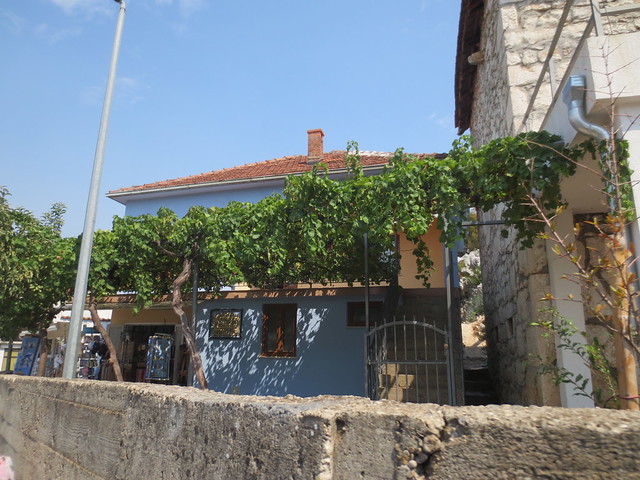
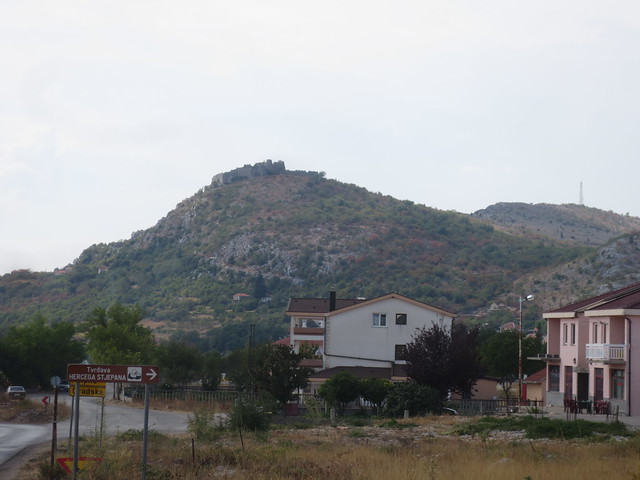
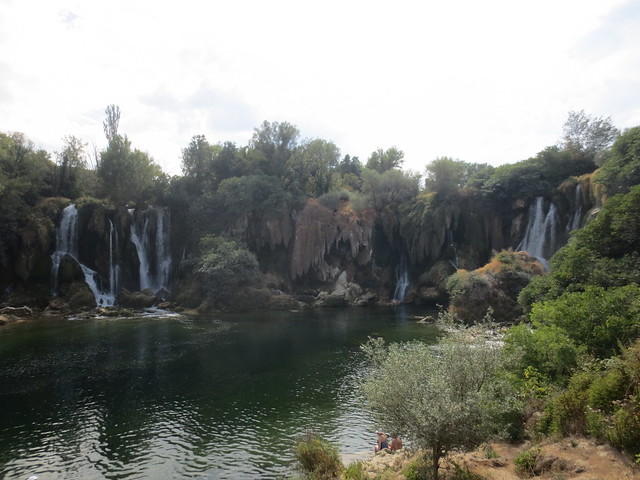
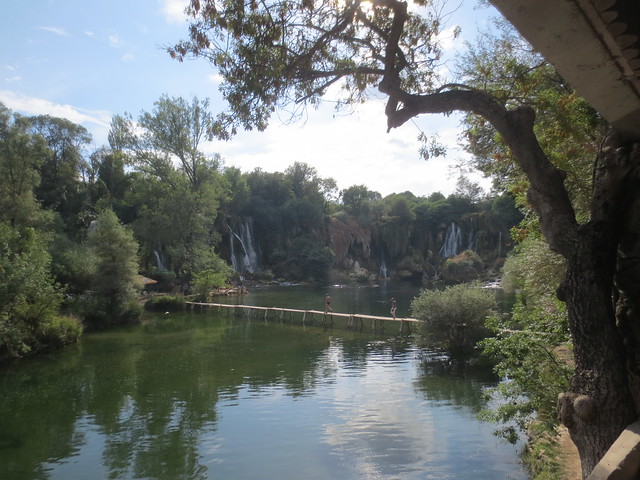
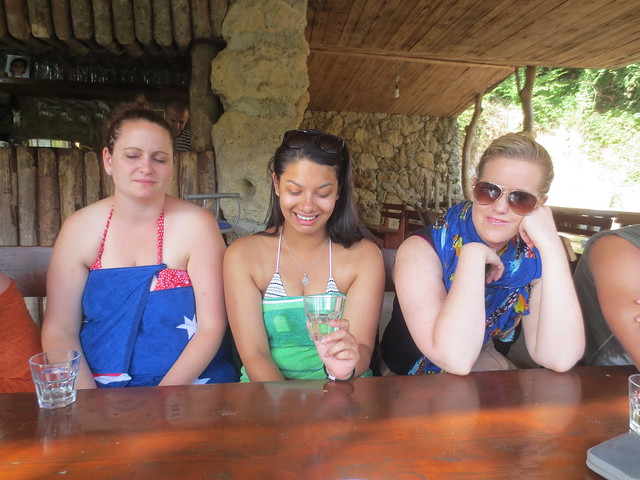
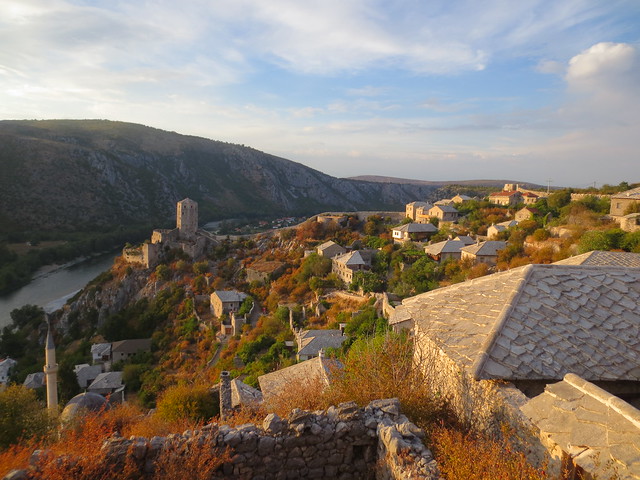
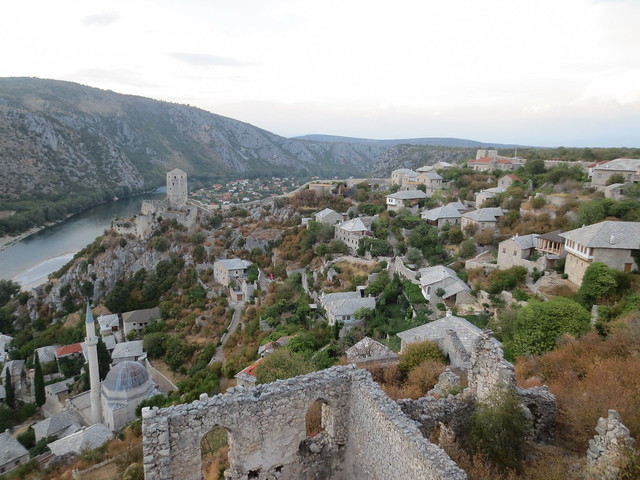
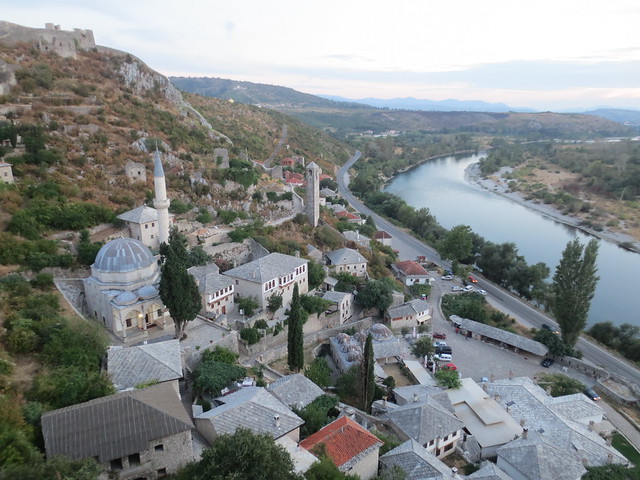
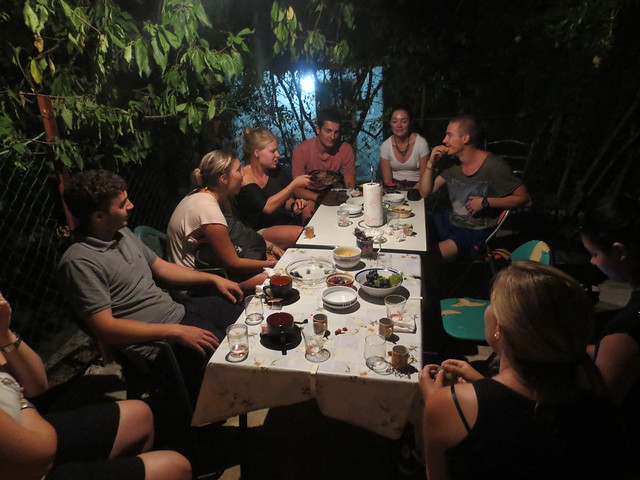
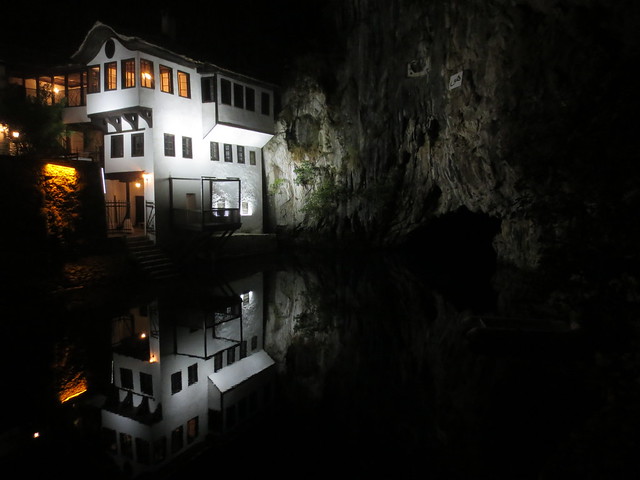
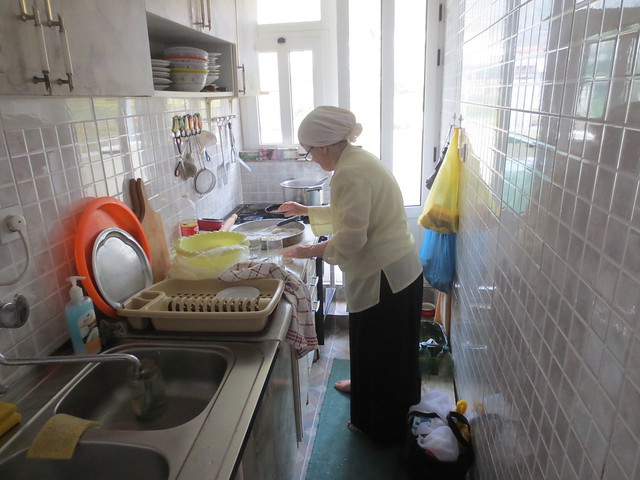
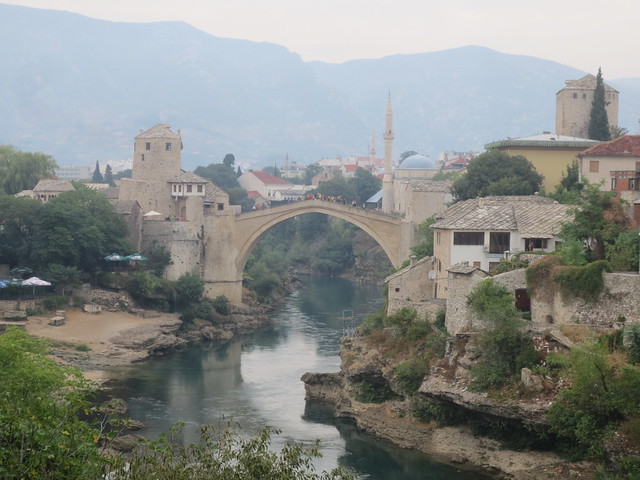
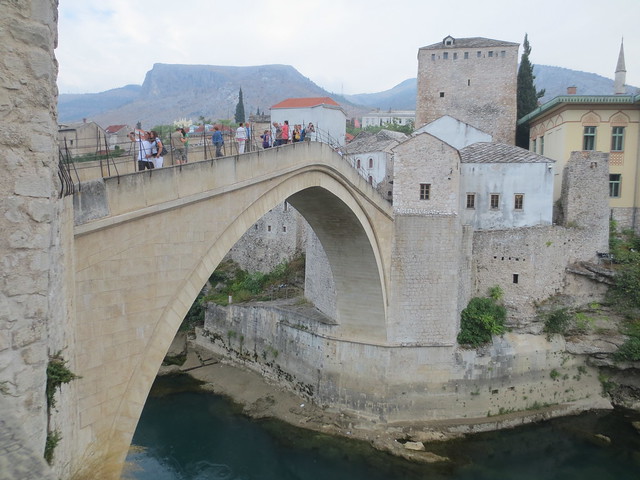
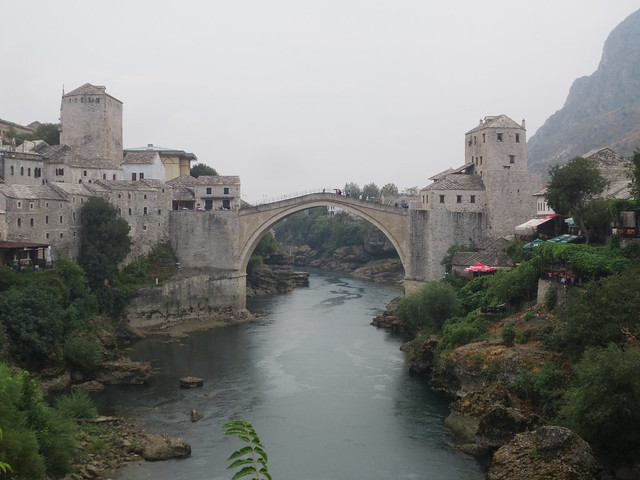
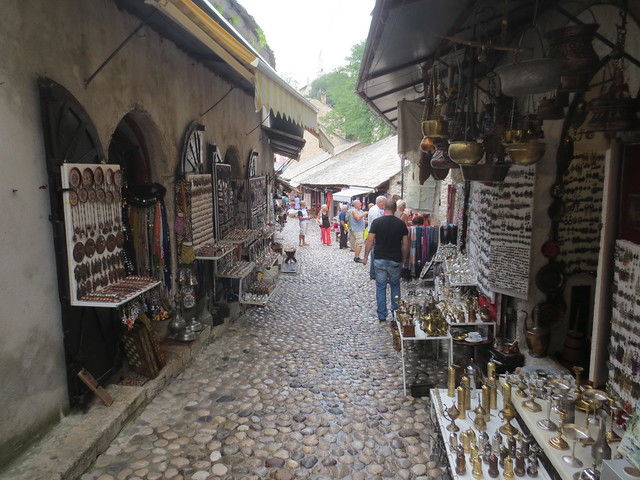
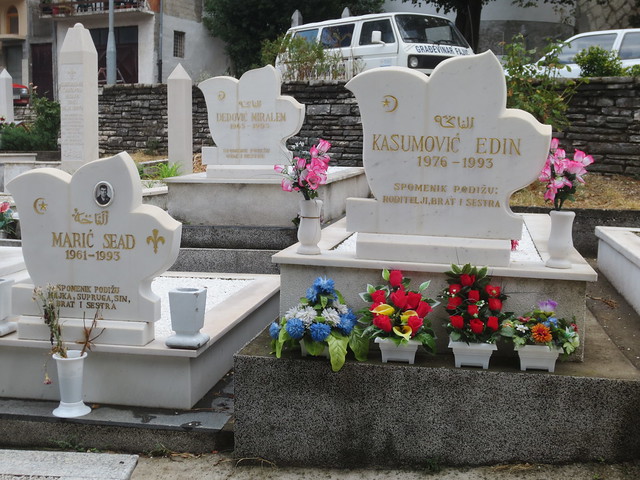
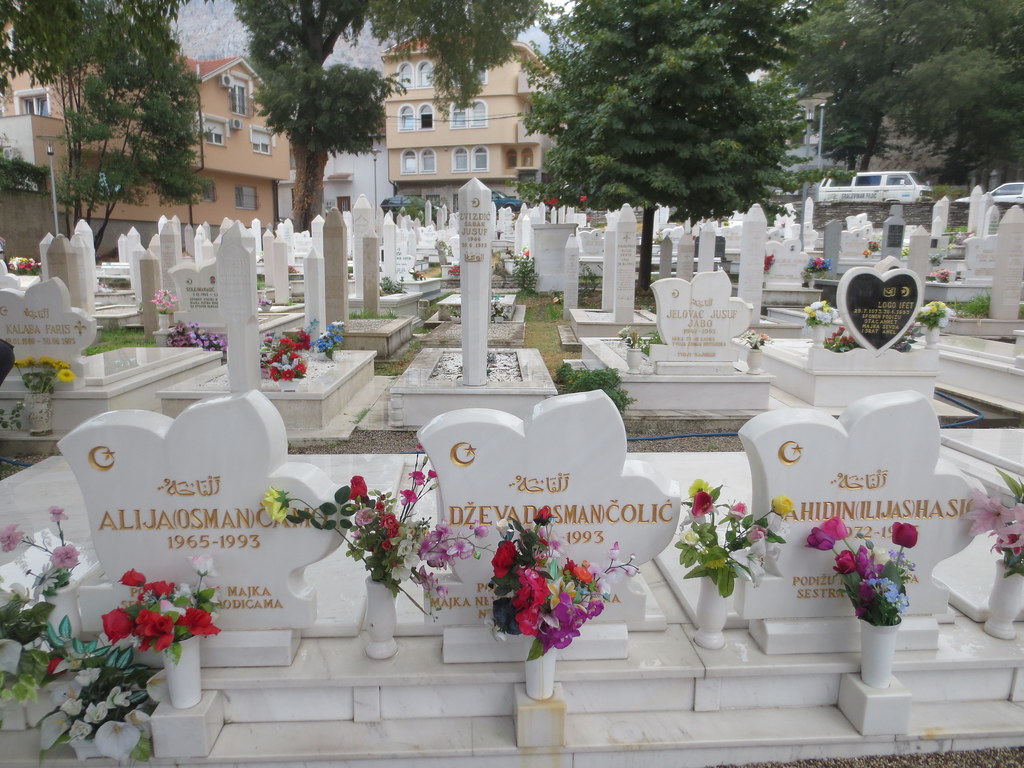


No comments:
Post a Comment